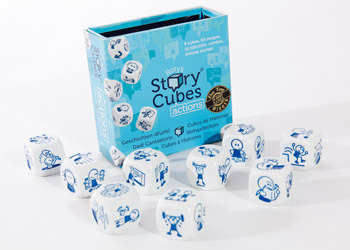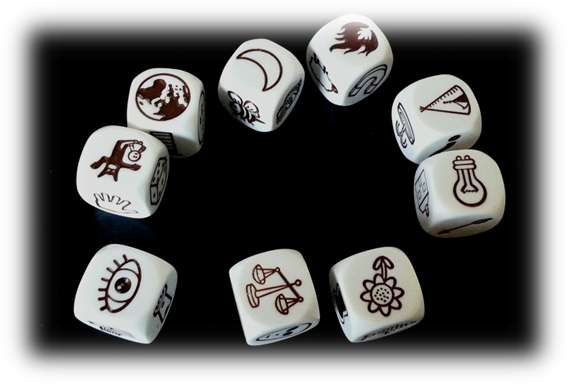Story Cubes – Have fun creating and telling stories with your kids
Reading children’s stories from books or even reciting them from memory are both excellent ways of sharing stories and making the most of story time but I recently came across a wonderful tool for making story telling a brilliant joint activity for my daughter and me.
I also thought that they’d make excellent Christmas presents for anyone with kids in the 5-10yr old range.

This is my daughter and I creating a story together using the story dice.
Flying back from a business trip to Dublin where I had spent a month working with an insurance company to map their business processes, I had to switch off my iPad for take-off and resorted to picking up the in-flight magazine for the airline.
Flicking through the magazine, I inevitably came across the section for the stuff that you can buy for ridiculous prices while on-board the aircraft. My eye was drawn to a headline piece about an “Irish Success Story” and a whole page dedicated to Rory’s Story Cubes.
I was genuinely really excited! The name of the product and the picture alone told me at once that I should buy some (though I must confess to being a cheapskate and taking a photo with my phone so I would remember to buy them from somewhere cheaper than the aeroplane).
What are story dice?
The premise is you have 9 dice each with a different image on each face (making a total of 10 million possible combinations). You roll the dice and start a story with “Once upon a time…” and use the face up images to prompt you with ideas to create a story from scratch.
This will be amazing to share with Olivia! I thought.
Creating a story with my daughter
A week later and I’m sitting down with O to have a go at creating a story. Now, technically, Story Cubes are for ages 6 and up but O has a great imagination and I was keen to have a go at creating a story with her.
The instructions are plain and simple : tell a story based on the images that come up on the cubes. Every story starts “once upon a time…”
So, I roll a dice and immediately Olivia wants to tell a story about a princess called Olivia…
Fair enough.
The first cube shows a flower, so I start talking about how Princess Olivia was walking in her garden in at the palace among all her favourite flowers…
Now it’s O’s turn to roll a cube, and it comes up with the image of fire. Of course this meant that the flower was on fire and the princess was devastated!
What fun and now we’ve had more practice together using the Story Cubes to create fun stories, she’s starting to get the hang of embellishing the story beyond the short and literal interpretation of the image that is displayed.
What’s great is that she really loves playing with them and it’s something that we do together and not only is she learning how to create and tell a story, but we have a laugh about it and I’m getting to practice shaping the stories we make so that they have a better self-contained structure (ie beginning, middle and end).
Experiment and develop your storytelling
For some reason, O and I have taken to rolling one dice at a time and telling the element of the story that corresponds to the image. We end up creating a linear stack of the face up dice along the table and we can look back at the images we used to progress the tale.
So far, we’ve only told stories that last for a single roll of all 9 story dice but there’s nothing to say that we won’t start wrapping around and creating stories that are longer.
This last weekend, Olivia even started adding events and characters outside of the dice and I have a suspicion it won’t be long before we’re wiling away car journey spinning yarns and making up wild and wonderful adventures.
I can’t wait and I can certainly recommend anyone with kids or who has friends with kids to get some of these. Rory has even produced additional sets for different scenarios :
Start your stories with “Far, far away…”

Depictions of verbs allowing real adventure stories to be made. Why not combine it with drawing or acting out the story at the same time

Just before I wrote this article, I rolled the dice and took this photo. What story would you tell from it?

Once upon a time…





